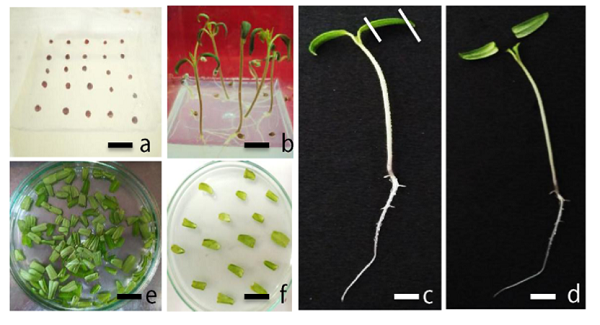Establishment of a highly efficient Regeneration system in Tomato var. Pusa ruby amenable to Agrobacterium tumefaciens Mediated Plant Transformation system
Pankaj Borgohain, Bhaben Chowardhara, Bedabrata Saha, Jay Prakash Awasthi, Sibashish Kitaniya, Lingaraj Sahoo, Sanjib Kumar Panda*
Research Article | Published: 11 January, 2019
First Page: 62
Last Page: 67
Views: 3779
Keywords: Agrobacterium tumefaciens, Plant transformation, tomato, hygromycin phosphotransferase (HPT), ZeBeta
Abstract
An efficient Agrobacterium tumefaciens mediated transformation scheme was constituted using tomato cotyledonary leaf explants. 8 day old tomato seedling were used for excision of the explants. The two day pre-cultured explants were co-cultivated with Agrobacterium tumefaciens strain EHA105 harbouring the plant binary vector pCXSN, for 2 days in dark condition. pCXSN contains hygromycin phosphotransferase (HPT) as selectable marker and belongs to ZeBata series of binary vectors. Full strength MS media added on with 2µM zeatin, 0.1 µM IBA, 25 mg/L hygromycin and 250mg/L cefotaxime was optimized for multiple shoot regeneration and finally rooted in media containing IBA. The transgenic events were confirmed by genomic DNA PCR and transcript abundance was checked by semi-quantitative PCR.

References
- American Association for the Advancement of Science (1985). A simple and general method for transferring genes into plants. Science, 227(4691): 1229-1231.
- An G, Ebert PP, Mitra A and Ha SB (1988). Binary vectors, pA3/1–19. Plant Molecular Biology Manual. Kluwer Academic Publishers, Dordrecht.
- Bartlett JG, Alves SC, Smedley M, Snape JW and Harwood WA (2008). High-throughput Agrobacterium-mediated barley transformation. Plant Methods 4(1): 22.
- Bird CR, Smith CJS, Ray JA, Moureau P, Bevan MW, Bird AS Schuch W (1988). The tomato polygalacturonase gene and ripening-specific expression in transgenic plants. Plant Mol Biol 11(5): 651-662.
- Chen S, Songkumarn P, Liu J and Wang GL (2009). A versatile zero background T-vector system for gene cloning and functional genomics. Plant Physiol 150(3): 1111-1121.
- Chyi YS and Phillips GC (1987). High efficiency Agrobacterium-mediated transformation of Lycopersicon based on conditions favorable for regeneration. Plant Cell Rep 6(2): 105-108.
- Chilton MD, Currier TC, Farrand SK, Bendich AJ, Gordon MP and Nester EW (1974). Agrobacterium tumefaciens DNA and PS8 bacteriophage DNA not detected in crown gall tumors. Proc Nat Acad Sci 71(9): 3672-3676.
- Devi R, Dhaliwal MS, Kaur A, Gosal SS (2008) Effect of growth regulators on in vitro morphogenic response of tomato. Indian J Biotechnol 7:526–530
- Davis ME, Miller AR and Lineberger D (1991). Temporal competence for transformation of Lycopersicon esculentum (L. Mill.) cotyledons by Agrobacterium tumefaciens: relation to wound-healing and soluble plant factors. J Exp Bot 42(3): 359-364.
- Ellul P, Garcia-Sogo B, Pineda B, Rios G, Roig L and Moreno V (2003). The ploidy level of transgenic plants in Agrobacterium-mediated transformation of tomato cotyledons (Lycopersicon esculentum L. Mill.) is genotype and procedure dependent. Theor Appl Genet 106(2); 231-238.
- Fillatti JJ, Kiser J, Rose R and Comai L (1987). Efficient transfer of a glyphosate tolerance gene into tomato using a binary Agrobacterium tumefaciens vector. Nature Biotechnol 5(7): 26.
- Herbers K and Sonnewald U (1996). Manipulating metabolic partitioning in transgenic plants. Trend Biotechnol 14(6): 198-205.
- Hamza S and Chupeau Y (1993). Re-evaluation of conditions for plant regeneration and Agrobacterium-mediated transformation from tomato (Lycopersicon esculentum). J Exp Bot 44(12): 1837-1845.
- Hood EE, Gelvin SB, Melchers LS and Hoekema A (1993). NewAgrobacterium helper plasmids for gene transfer to plants. Trans Res 2(4): 208-218.
- Liu THA, Stephens LC and Hannapel DJ (1995). Transformation of Solanum brevidens using Agrobacterium tumefaciens. Plant Cell Rep 15(3-4): 196-199.
- Metwali EM, Soliman HI, Fuller MP and Almaghrabi OA (2015). Improving fruit quality in tomato (Lycopersicum esculentum Mill) under heat stress by silencing the vis 1 gene using small interfering RNA technology. Plant Cell Tissue Organ Cult (PCTOC) 121(1): 153-166.
- McCormick S, Niedermeyer J, Fry J, Barnason A, Horsch R and Fraley R (1986). Leaf disc transformation of cultivated tomato (L. esculentum) using Agrobacterium tumefaciens. Plant Cell Rep 5(2): 81-84.
- Ohki S, Bigot C and Mousseau J (1978). Analysis of shoot-forming capacity in vitro in two lines of tomato (Lycopersicon esculentum Mill.) and their hybrids. Plant Cell Physiol 19(1): 27-42.
- Pino LE, Lombardi-Crestana S, Azevedo MS, Scotton DC, Borgo L, Quecini V and Peres LE (2010). The Rg1 allele as a valuable tool for genetic transformation of the tomato 'Microtom' model system. Plant Meth 6(1): 23.
- Pawar BD, Jadhav AS, Kale AA, Chimote VP and Pawar SV (2012). Zeatin induced direct in vitro shoot regeneration in tomato (Solanum lycopersicum L.). The Bioscan 7(2), 247-250.
- Pfitzner AJ (1998). Transformation of tomato. In: Plant Virology Protocols, Humana Press. Pp. 359-363,
- Römer S, Fraser PD, Kiano JW, Shipton CA, Misawa N, Schuch W and Bramley PM (2000). Elevation of the provitamin A content of transgenic tomato plants. Nature Biotechnol 18(6): 666.
- Raj, S.K., Singh, R., Pandey, S.K., Singh, B.P., 2005. Agrobacterium-mediated tomato transformation and regeneration of transgenic lines expressing Tomato leaf curl virus coat protein gene for resistance against TLCV infection. Curr. Sci. 88 (10), 1674–1679.
- Staskawicz BJ, Ausubel FM, Baker BJ, Ellis JG and Jones JD (1995). Molecular genetics of plant disease resistance. Science 268(5211): 661-667.
- Velcheva M, Faltin Z, Flaishman M, Eshdat Y and Perl A (2005). A liquid culture system for Agrobacterium-mediated transformation of tomato (Lycopersicon esculentum L. Mill.). Plant Sci 168(1): 121-130.
- Van Eck JM, Blowers AD and Earle ED (1995). Stable transformation of tomato cell cultures after bombardment with plasmid and YAC DNA. Plant Cell Rep 14(5): 299-304.
- Van Vu T, Choudhury NR and Mukherjee SK (2013). Transgenic tomato plants expressing artificial microRNAs for silencing the pre-coat and coat proteins of a begomovirus, Tomato leaf curl New Delhi virus, show tolerance to virus infection. Virus Res 172(1-2): 35-45.
- Wang H, Huang Z, Chen Q, Zhang Z, Zhang H, Wu Y and Huang R (2004). Ectopic overexpression of tomato JERF3 in tobacco activates downstream gene expression and enhances salt tolerance. Plant Mol Biol 55(2): 183-192
Author Information
Plant Molecular Biotechnology Laboratory, Department of Life Science and Bioinformatics, Assam University, Silchar 788011, INDIA